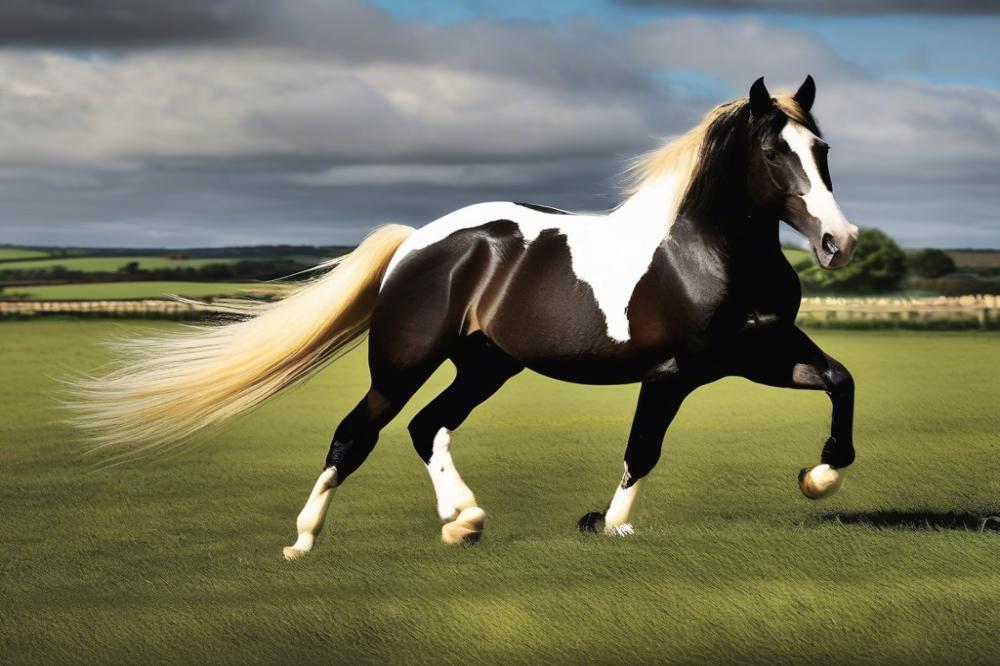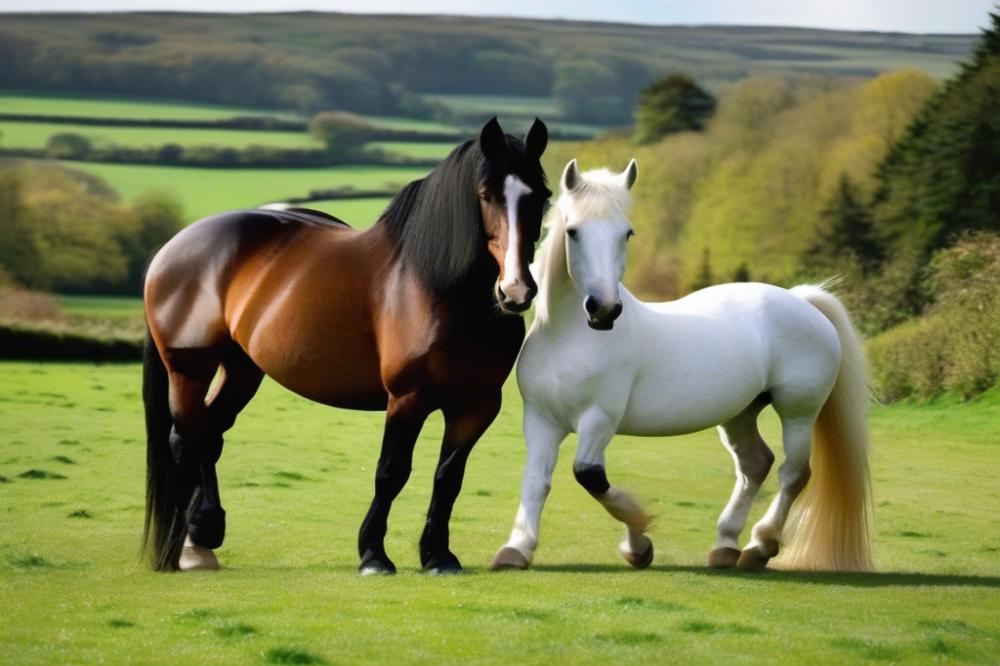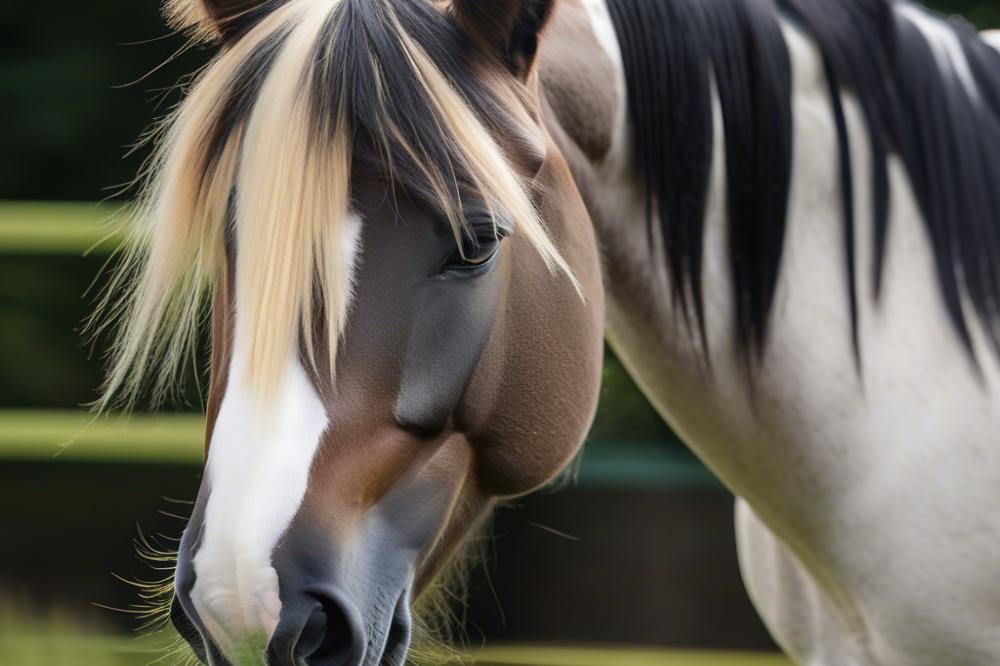Discovering the Irish Cob Horse
The Irish Cob, a magnificent creature known for its striking appearance and gentle demeanor, holds a special place in the hearts of horse lovers. With its sturdy build and flowing mane, this breed is not just a pretty face. These four-legged wonders are celebrated for their versatility, whether they are pulling carriages or performing in riding arenas. When you see an Irish Cob, you can appreciate the pride of a heritage that goes back centuries.
Why Horse Shows Matter
Horse shows play a vital role in showcasing the unique qualities of each breed. These events offer a stage where the Irish Cob shines brightly among its equestrian peers. Attending one of these shows can be like walking into a vibrant tapestry of colors and personalities, filled with caring owners and their beloved horses. Besides the chance to admire beautiful animals, spectators often learn a lot about horse care and horse training techniques. It’s a learning experience wrapped in a fun day out.
The Purpose of This Article
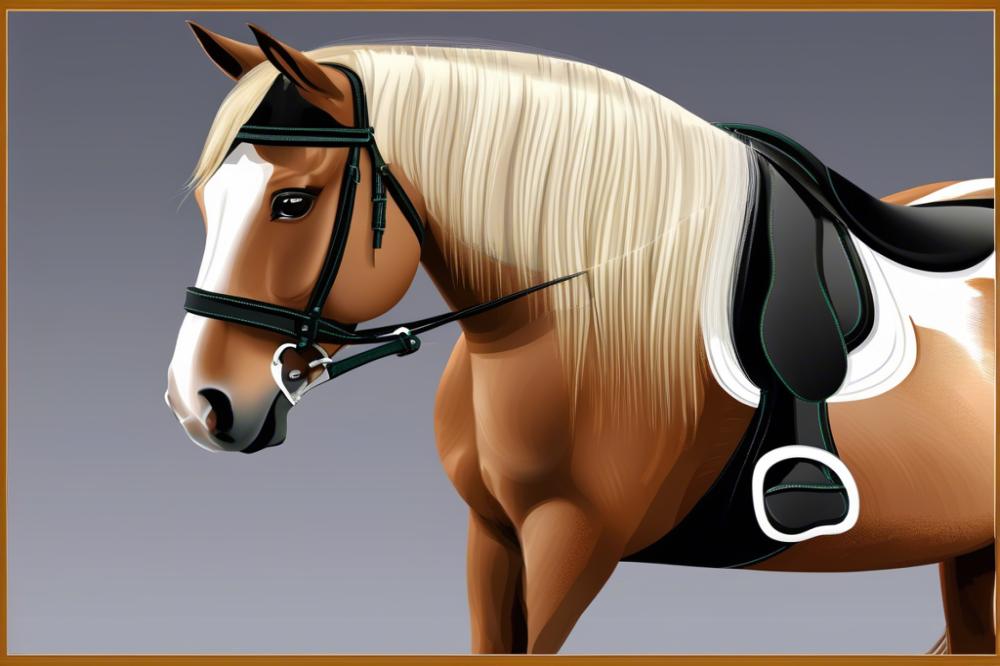
This article aims to guide you through the exciting world of showing the Irish Cob. By diving into the event schedule and the keys to success in the show ring, we want to provide helpful insights for those looking to showcase their horses. Have you ever wondered about the best equestrian techniques for preparing your Irish Cob for competition? Well, you’re in the right place! We’ll touch on everything from grooming tips to training routines so that you and your chap don’t feel like fish out of water.
So, whether you’re a seasoned horse enthusiast or just someone curious about breeds of horse, sit back and enjoy the ride. Let’s explore the wonderful journey of showing these remarkable animals. And who knows? You might even find a little inspiration along the way, just like when one discovers the beauty within the myriad indian horse breeds. Ready to trot into this adventure?
Understanding the Irish Cob Horse
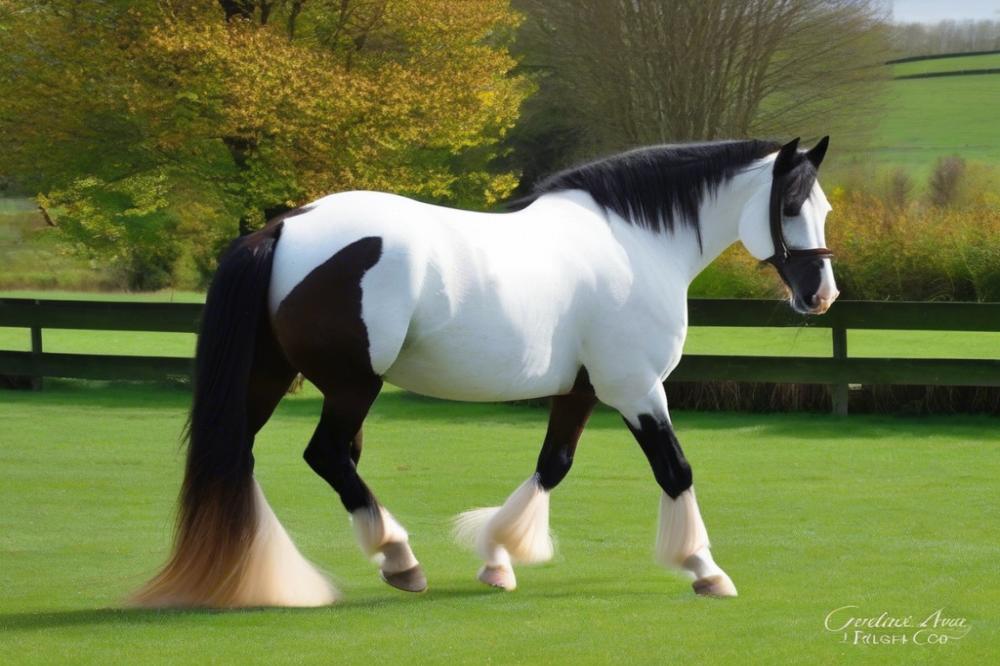
History and Origin of the Irish Cob
The Irish Cob horse has a rich history that dates back centuries. Originating in Ireland, this breed was developed by the Romani people and local farmers. They needed a strong horse that could handle both leisure and hard work. Over time, these sturdy creatures became known for their versatility. People began to notice their charming looks and gentle nature. By the late 20th century, the Irish Cob became popular in equestrian events across the globe. They truly are a piece of history that you can ride!
Physical Characteristics and Traits
Irish Cobs are famous for their impressive size and sturdy build. Most stand between 13.2 and 15.2 hands high. Their thick mane and tail flutter beautifully in the wind. Many have a variety of colors, from solid black to stunning piebald patterns. Muscles are well-defined, showcasing strength and power. Feathering on the legs is a signature trait. This horse’s calm demeanor is just as eye-catching as its appearance. Equestrian techniques can highlight these traits when performing in shows.
Temperament and Suitability for Various Disciplines
You’ll find that the temperament of the Irish Cob is quite mellow. They’re known for being friendly and easy to train. Whether you’re a beginner or an experienced rider, they can adapt well to different riders. Family-friendly, they often make great partners for children. These horses can excel in many disciplines, from trail riding to dressage. Their willingness to work shines during training sessions. Horse care is essential, but they typically don’t require anything out of the ordinary. If you maintain a good routine, they thrive! Whether it’s a leisurely ride or preparing for an event schedule, the Irish Cob won’t let you down.
Preparing for Irish Cob Horse Shows
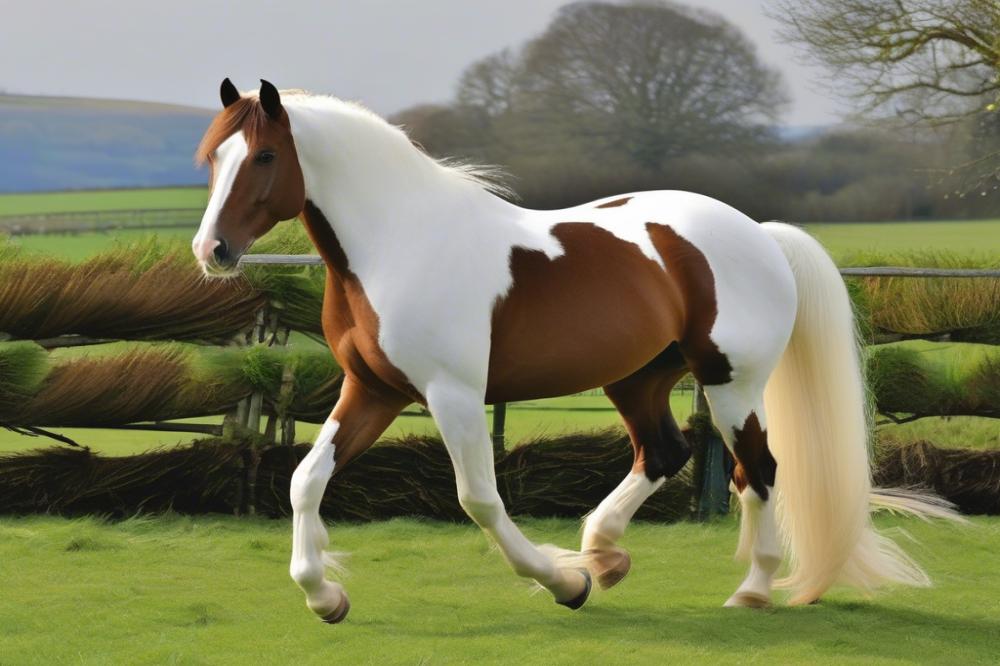
General Health and Grooming Tips
Keeping your Irish Cob in top shape is key to a successful show. Regular vet check-ups make sure your horse is healthy. Pay attention to the hooves; they need to be trimmed and polished. A clean coat is also vital. Daily grooming routines remove dirt and mess. Brush your horse until it shines like a new penny. Don’t forget the mane and tail. A good detangler can work wonders, making those knots disappear. Shiny horses attract attention, and that’s half the game at equestrian events.
Nutrition plays a significant role as well. Feed your horse high-quality hay and grains. Hydration is critical, too. Fresh water should always be available. A healthy horse can showcase its talents. Always be mindful of weight; you wouldn’t want your equine friend to be either too skinny or a bit on the hefty side. Keeping things balanced is best.
Training Requirements and Techniques
Training is essential, and starts well before the event schedule. Building a solid bond with your Irish Cob makes a world of difference. Consistency is your best friend here. Spend time working on basic commands, groundwork, and being comfortable around you. Practice the show routines regularly. The more familiar your horse is with what to expect, the better the performance.
Obstacles may come into play during training. Why not set up a mini-course at your barn? Jumping over small fences, walking through cones, and even trotting in straight lines can improve your performance. Use positive reinforcement too. Treats and praise can motivate your horse. Keep it light and enjoyable. If you’re having fun, your horse likely will, too.
Important Equipment and Tack Selection
Choosing the right tack is crucial for both comfort and style. Look for a saddle that fits your Irish Cob well. A poorly fitting saddle can lead to issues. Comfort is king! It’s important that your horse enjoys wearing tack while working. That bridle? Make sure it suits both horse and rider. It should be lightweight yet sturdy.
Don’t overlook safety equipment either. Helmets, gloves, and boots are a must for you, as well as your horse’s gear. Sometimes, the flashy colors and styles can be tempting. But practical gear sometimes wins the day! Keep it functional while also giving your Cob some flair. Dress him up, but don’t sacrifice comfort for style.
When you combine all these elements—health, training, and gear—you set yourself up for a promising showing. Prepare, practice, and enjoy the journey with your Irish Cob. There’s nothing quite like the thrill of watching your hard work come to life at the event. And remember, there’s always next time! You’ve got this!
Show Categories and Classes
When it comes to showcasing the Irish Cob, there are a variety of show types to explore. Enthusiasts can choose between in-hand and ridden classes. Each category offers something special. Think of in-hand shows as a chance for the horse and handler to shine together without any riding involved. You simply walk around, showcase the horse’s beauty, and let the judges marvel at the displays of skill and elegance.
Ridden classes, on the other hand, bring an exciting twist. Riders complete maneuvers on horseback, displaying both the horse’s training and the rider’s ability. Jumping classes often happen in these events too. Just imagine galloping with your mount over colorful obstacles—what a thrill!
Classes for Irish Cobs
Many classes exist specifically for Irish Cobs. There are categories for different ages and skills. Youngstock classes focus on horses under the age of three. Here, the judges look for promising traits that hint at future greatness. Then there are classes for stallions, mares, and geldings, each with specific requirements.
For those who fancy the combination of a beautiful horse and impressive riding skills, the British Riding Club classes become quite the treat. This allows riders to showcase their training techniques while highlighting the distinct characteristics of the Irish Cob. Additionally, there are classes just for traditional styles, including sidesaddle riding. Picture a graceful rider in elegant clothing! It’s a sight that captures the essence of equestrian traditions.
Criteria for Judging and Scoring Factors
Now, let’s talk about judging. Judges assess several factors when scoring horses in shows. First off, appearance counts a lot. The coat should shine, and the overall conformation must impress. Movement is another key area. Those majestic strides of an Irish Cob can sway the judges’ opinions. The way a horse trots and canters speaks volumes about its training and temperament.
Horse care comes into play too. Healthy horses usually perform better. Judges also look at manners and behavior. A well-behaved horse stands out in the ring, and who doesn’t love a horse that is calm under pressure? Equestrian techniques can sometimes give the edge, too. A rider’s skill in handling the horse clearly reflects on the judging sheets.
Don’t forget that showmanship plays its part! The bond between horse and rider can really turn heads. When they move as one, the crowd can feel it. That connection often translates into top scores.
Each class has its specific event schedule, so knowing these details helps owners prepare effectively. Understanding the nuances and getting ready takes not only effort but a good chunk of dedication. In the end, whether you’re competing or just watching, it all adds up to a fantastic time celebrating the wonderful Irish Cob!
Tips for Successful Showing
Best Practices for Handlers and Riders
The bond between horse and rider is everything. Always try to develop a strong connection with your Irish Cob. That bond makes showing much smoother. Communication is key. Use clear cues to let your horse know what you want. Training sessions should focus on both connection and technique. Take time to teach your horse the ropes.
Proper warm-up is crucial before any equestrian events. Spend at least 20 minutes getting your horse used to the show environment. A calm horse is a happy horse. Use this time to practice your movements and transitions. Trust me, a well-prepared horse will stand out.
Don’t forget about the little details. Handlers should be aware of their appearance too. Wearing appropriate attire can boost confidence. A neatly dressed handler gives the impression of professionalism.
Importance of Presentation and Turnout
Presentation is everything in showing. A polished look can turn heads in the ring. Clean equipment, neat braids, and a bright coat spark interest. A well-groomed horse is often a winner before the class even starts. Regular grooming should be part of your horse care routine.
Color coordination might seem trivial but it matters! Matching your riding outfit to your horse’s tack creates an eye-catching look. You want the judges to see coordination, not chaos.
Keep your horse’s mane and tail in check. A tidy mane can make a huge difference in the way your horse presents itself. Just remember, a little effort goes a long way. The event schedule allows time for last-minute touch-ups, so utilize that time wisely!
Strategies for Managing Horse Behavior in the Show Ring
Every horse has its quirks. You never know when a sudden spook may happen in the ring. Staying calm is critical. Horses can sense your emotions. If you panic, they might too. Take a deep breath and remember your training.
Practice distracting your horse during training to minimize surprises later on. Use familiar equestrian techniques in the ring to keep them engaged. Have toys or treats ready to create positive associations with the environment.
It’s not just about the horse; it’s about you too. Stay relaxed in the saddle. If you’re tense, it can reflect on your horse’s behavior. Think of it like this: if you’re smiling, your horse will probably be smiling too!
Building consistency is also a winning strategy. Attend as many practice shows as you can. Getting your horse accustomed to the setting can help reduce anxiety. More practice means better results on show day!
Challenges Faced in Showing Irish Cobs
Common Issues Encountered During Competitions
Competing can be thrilling, but it’s not without its problems. Many exhibitors face challenges like nerves or unexpected behavior from their mounts. The hustle and bustle of equestrian events can overwhelm both the horse and the rider. Lost equipment is another frequent headache. Have you ever searched high and low for that one glove? It’s part of the charm, but it can lead to panic just before you enter the ring.
During the showing, some horses might decide they’re more interested in the spectators than the task at hand. The Irish Cob, with its spirited nature, may get distracted. Keeping their attention is key. A few handy strategies include familiarizing your horse with the venue beforehand, if possible. This way, both of you can feel a bit more at ease.
Overcoming Breed-Specific Challenges
Irish Cobs are known for their gentle giants, but they bring unique hurdles to the table. Their size can be an advantage or a challenge. Maneuvering a larger horse can be tricky, especially in tight spaces or crowded rings. It’s essential to practice with your horse to develop a good feel for each other’s movements.
A horse’s coat often needs extra prep time compared to other breeds. Show day can bring unforeseen weather changes, so applying the right horse care beforehand is crucial. If the coat gets muddy or dusty, your long hours of grooming can go down the drain! Quick touch-ups with a damp cloth can do wonders. Staying prepared helps keep things flowing smoothly.
Tips for Dealing with Competition Nerves
Almost every rider has felt those jittery butterflies before a show. Shaking hands and racing hearts are quite common. Try deep breathing exercises to settle your nerves. Inhale deeply through your nose and let it all out slowly through your mouth. Do this a few times, and you’ll feel calmer.
Visualization is another powerful trick. Picture yourself riding confidently in the ring. Imagine the applause and the thrill of a good performance. This technique can take your mind off concerns. Also, remember that everyone is rooting for you! You aren’t alone; instead, you’re part of a shared experience.
Riding with a buddy can help ease pre-show anxiety as well. Friends can provide support and humor on a busy competition day. A few laughs can lighten the mood and keep the atmosphere friendly. Keeping your focus on the joy of the show can make all the difference in how you, and your trusty Irish Cob, perform.
The Role of Irish Cob Associations and Clubs
When it comes to promoting the Irish Cob, associations and clubs play a vital role. Organizations dedicated to these magnificent horses work tirelessly to support shows and events. They unite horse lovers under a common banner, fostering a community that thrives on shared passion. Without these groups, it would be a lot harder to navigate the exciting world of equestrian events.
Getting involved with local clubs can be a game changer. Networking with other enthusiasts opens doors to valuable friendships and mentorship. It’s like finding your tribe, where everyone has stories to share and tips to offer. You might hear about a fantastic training technique or learn the best horse care practices just over a cup of coffee with a fellow member.
Educational opportunities abound in these associations. Many clubs organize workshops that cover horse training, grooming, and various equestrian techniques. Imagine stepping into a seminar where you learn about the latest in horse care from experts. You’ll leave with new insights and maybe even a few funny tales about mishaps in the saddle. Plus, members often get access to exclusive event schedules, making it easier to plan your horse showing adventures.
Members also have the chance to contribute ideas to improve shows or events. Whether it’s suggesting a new class or voicing concerns about horse welfare, everyone’s input matters. Engaging with these organizations can give you a sense of ownership and pride. After all, a well-organized show benefits everyone involved, especially the horses.
Many clubs also hold fun events, like picnics or informal competitions. These gatherings are perfect for unwinding and connecting with fellow Irish Cob fans. Sharing laughter over stories of horses acting silly can light up the day. Remember, it’s not just about the ribbons; it’s also about building a community that cares.
Final Thoughts on the Irish Cob Showing Experience
Recapping the significance of Irish Cob shows, they serve as a delightful celebration of this remarkable draft horse breed. These events don’t just showcase the beauty and versatility of the Irish Cob; they also create a fantastic community of enthusiasts who share stories, tips, and, of course, a good laugh or two. Imagine standing beside other passionate owners, swapping tales about your horse’s antics while you await their turn in the ring. There’s a sense of camaraderie that makes every show special.
Consider this an open invitation to join in! Whether you own an Irish Cob or just admire the breed’s striking appearance, participating in the showing community can be rewarding. There’s no need to be intimidated. After all, everyone started somewhere. Each show offers a chance to learn, meet friends who share your interests, and discover the joy of competition. Plus, you’ll likely find that the horses have their own unique personalities that can make for some truly entertaining moments.
Looking ahead, the Irish Cob horse breed holds a bright future filled with potential and possibilities. As more people understand the value and charm of these equines, their popularity will undoubtedly increase. This horse group called Irish Cobs is not just about tradition; it’s about embracing the future while honoring the past. Let’s keep supporting each other and these magnificent animals. Remember, it’s not just about the ribbons but cherishing the journey and the relationships we build along the way.
So, whether you’re an experienced exhibitor or just an admirer, let’s keep the spirit of the Irish Cob alive. Saddle up, get involved, and let those horses gallivant into the future with grace and glory!

